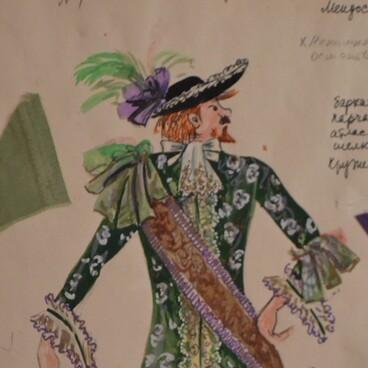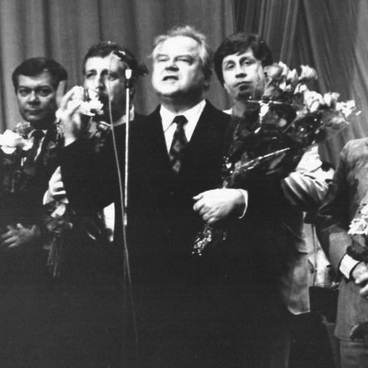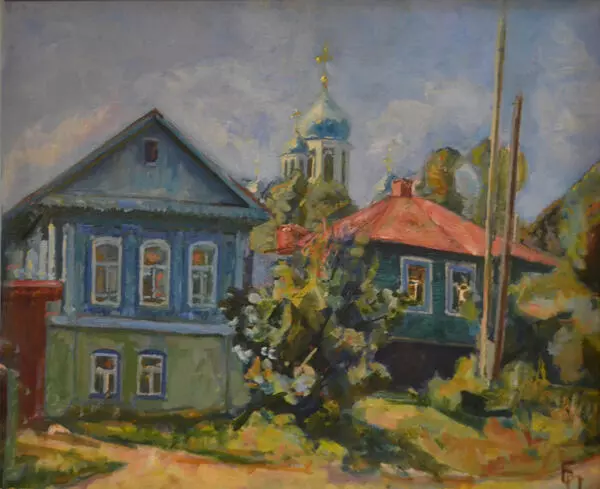Pavel Burdukov is a graduate of the Yeletsk Art College named after T.N. Khrennikov, a student of the famous landscape painter Nikolay Klimov. ‘View with the Cathedral’ is an early work by Burdukov, in which he has already begun his journey to find his own unique style.
The artist depicted the main attraction of the town — the Ascension Cathedral. It was built in the second half of the 19th century by the project of Konstantin Ton — a famous architect, rector of the Imperial Academy of Arts, the author of the building of the Grand Kremlin Palace and the Cathedral of Christ the Savior in Moscow.
Burdukov used the favorite subject of Yelets artists — the blue domes of the cathedral over small residential buildings. He chose the view of the Cathedral from Profsoyuznaya Street — one of the petty bourgeois streets of the town. In the foreground you can see wooden buildings that are buried in greenery of gardens and front gardens. The author added to the picture an important feature of Yelets architecture — a typical two-story house, the first floor of which is made of stone, and the second one is made of wood. This construction technology was often used due to its strength and cheapness — wood was a rather expensive material, so even the decoration of the windows was modest.
Numerous shades of light blue and blue colors give the picture lightness and airiness. The domes of the Cathedral resonate with the roofs and walls of residential buildings — together they seem to float across the sky above the trees, among white clouds. To convey the mood of a joyful summer morning, Burdukov uses rich red-brown, green and yellow colors that create the effect of bright sunlight.
The construction of the Ascension Cathedral went on for 44 years, but the project was never completed — the church does not have a bell tower. In the 30s of the XX century, the Cathedral was closed to the public, and in 1941 the German troops who occupied the town used it as a garage for armors. In 1948 the building was renovated and returned to the Orthodox Church. Since then, it has been the main operating temple of Yelets and the architectural dominant of the town, and local painters, photographers and filmmakers often devote works to it.
The artist depicted the main attraction of the town — the Ascension Cathedral. It was built in the second half of the 19th century by the project of Konstantin Ton — a famous architect, rector of the Imperial Academy of Arts, the author of the building of the Grand Kremlin Palace and the Cathedral of Christ the Savior in Moscow.
Burdukov used the favorite subject of Yelets artists — the blue domes of the cathedral over small residential buildings. He chose the view of the Cathedral from Profsoyuznaya Street — one of the petty bourgeois streets of the town. In the foreground you can see wooden buildings that are buried in greenery of gardens and front gardens. The author added to the picture an important feature of Yelets architecture — a typical two-story house, the first floor of which is made of stone, and the second one is made of wood. This construction technology was often used due to its strength and cheapness — wood was a rather expensive material, so even the decoration of the windows was modest.
Numerous shades of light blue and blue colors give the picture lightness and airiness. The domes of the Cathedral resonate with the roofs and walls of residential buildings — together they seem to float across the sky above the trees, among white clouds. To convey the mood of a joyful summer morning, Burdukov uses rich red-brown, green and yellow colors that create the effect of bright sunlight.
The construction of the Ascension Cathedral went on for 44 years, but the project was never completed — the church does not have a bell tower. In the 30s of the XX century, the Cathedral was closed to the public, and in 1941 the German troops who occupied the town used it as a garage for armors. In 1948 the building was renovated and returned to the Orthodox Church. Since then, it has been the main operating temple of Yelets and the architectural dominant of the town, and local painters, photographers and filmmakers often devote works to it.




